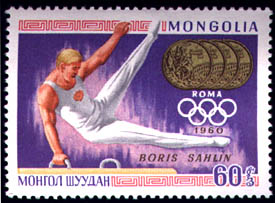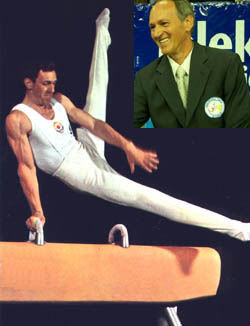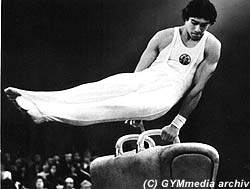 |
 The technique on Pommelhorse (II)
The technique on Pommelhorse (II)
The oldest
description of gymnastics on an artificial horse is over 600 years old.
It was written by a Renatus Vegetius , who, in his four volume “Overview
of the Roman Army”, describes soldiers using a wooden horse for practice.
In the 17th century a drill- instructor developed the art of equestrian
acrobatics from this description. In the early 19th century the wooden pommels
were replaced by a biegel, and the wooden horse developed into a schwingel'
covered in leather.
|
|
|
Today's
fascinating and dynamic routines on a modern pommel horse are
hardly reminiscent of the early forms of movement on this apparatus.
The development was massively influenced by the
flexible and innovative solutions offered by renowned apparatus
manufacturers.... |

German
|
|
|
|
Trends
of Pommel Horse Routines of the Past Five Decades (I)
(by Heinz Neumann
(GER),
international judge for many years)
|
|

Heinz Neumann
(Germany)
|
The author:
Potsdam native Heinz Neumann
(born November 20, 1931)
- was a coach at the former Army Sports Club "ASK Potsdam"
in Potsdam,. Germany, from 1954 to 1992. He also served
as head coach for the GDR team at the 1964 Tokyo Olympics.
Later on, he, who has always loved paying special attention
to details, focussed on the specialities of the most complex
of apparatus, pommel horse.
He was the first A judge in history (i.e. second head judge,
responsible for difficulty and special requirements) and was
a judge at every major international competition from 1965 to
1971. He judged his first competition in 1958 and continued
judging internationally until the mid 1990s, and is an active
judge until this day. |
|
|
. |
Heinz
Neumann is considered
one of the most knowledgeable pommel horse experts world wide,
who has a particular reputation of having a knack for details.
|
The
1950s - The Soviet Era |
|
Soviet gymnasts
went right to the top at their first international appearance
at the 1952 Olympics in Helsinki. They were impressive on pommel
horse, showing new elements and lifting the sport to a new level
with the extreme confidence with which they performed.
The "Shaginyan",
named after Grant Shaginyan, the 1954 world champion on pommel
horse, became a standard element among top pommel horse workers
in the 1960s. With slight changes, it would remain the most popular
dismount in throughout the 1970s. The 1958
FIG code of points already included the expression "Russian".
|
 World
Champion 1958:
World
Champion 1958:
Boris Schachlin 
(on a Mongolian stamp: Olympic Games 1960, Roma)
|
|
This element,
and its variations, would become one of the most common basic elements
of many a pommel horse routine. Even today, the Russian in its more
complex forms (triple on the end of the horse or on one pommel)
remains an important component of pommel horse routines.
|
|
The
1960s - The Cerar Years |
|

Cerar
formerly and today
|
<<
Miroslav
Cerar was a pommel horse virtuoso, who took the motto
"beauty before difficulty" to perfection. He showed
elegance, extension and incredible confidence in all of his big
international competitions.
Even though he didn't pioneer any
new elements, his contribution to gymnastics in terms of flawless
execution is invaluable and an example to gymnasts everywhere.
The tendency towards one pommel work was already noticeable during
Cerar's career. Yu Lie Feng
of China was first performed his unique circles on one pommel
at 1962 world championships in Prague.
At the 1968 Olympics in
Mexico City Japanese gymnasts Sawao Kato
and Eizo Kenmotzu performed
the "Stoeckli followed by immediate B" that the Americans
had introduced in a 1964 manual.
One pommel work was further facilitated by improvements of the
structure of the pommel, for instance its flattening and lengthening.
|
The
"Nikolai spindle" (immediate Stoeckli B on one pommel,
three times) was invented in 1979 by Berlin native Michael
Nikolai,
who tied for the 1981 world pommel horse title
with Chinese Li Xiaopeng.
Highly rewarded by the code of points, one pommel work would become
more and more popular, especially in the 1990's. |
|

|
|
|
|
|